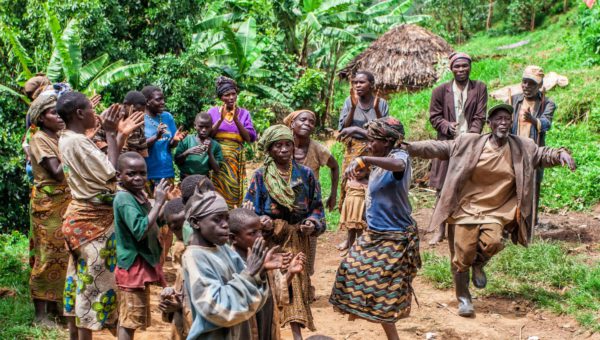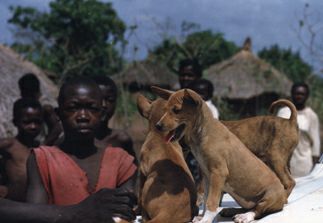Pigmeus
Os povos caçadores e coletores da África Central conhecidos como pigmeus vivem nas florestas tropicais da África Central e se dividem em vários grupos étnicos: Os Baka, que vivem no Camarões, Gabão e Congo; Os Bakola-Bagyeli que vivem no Camarões e Guiné-Equatorial; Os Bedzan dos Camarões; Os Bakoya do Gabão; Os Aka da República Centro-Africana. Os aspectos gerais desses povos semi-sedentários que varia entre si, principalmente na parte cultural, tipo de arquitetura, os rituais, as músicas e as danças. Porém os grupos étnicos desenvolvem variadas atividades como: a tecelagem com vibra vegetal (cestos e esteiras); a caça com arcos, bestas e armadilhas; a pesca com redes e pirogas e em barragens de pequenos rios; o preparo de alimentos à base de mandioca, de banana, de amendoim, de óleo de palma, de milho, de inhame, de mel, de cogumelos, de cupins, de lagartas, de peixes; a agricultura é de subsistência com o método de corte e queima do plantio.

Pigmeus de Uganda. Foto: Travel Stock / Shutterstock.com
Em África as menções mais antigas sobre os Pigmeus são encontradas no Antigo Egito, na sexta dinastia egípcia, entre os séculos XXIII e XXII a.C, no texto de uma carta do faraó Pepi II que agradece Herkhuf por ter apresentado um anão chamado Deng. Em relatos orais dos Mongo, da República Democrática do Congo, Nsong-a-Lianja, fala sobre o povoamento do vale do rio Congo e dizia que os pigmeus viviam nas florestas equatoriais e ao norte da floresta tropical, mas foram em direção ao centro da floresta devido a chegada de indivíduos de alta estatura que falavam a língua banto. É possível encontrar esses mesmos relatos orais em outras populações banto. Muitos estudiosos dos povos africanos da antiguidade, ao estudarem gênero de vida e a língua, apontam que os Pigmeus, junto com os San da savana e os Kwadi de Angola, sejam um dos remanescentes das populações humanas mais antigas.
A origem do nome Pigmeu vem das referências da mitologia e da oralidade e vem da palavra grega Pygmaîos (do latim Pygmaeus) que significa literalmente “um côvodo de altura”. Côvodo é uma medida de comprimento usada por várias civilizações antigas que equivale a 66 centímetros. O poeta grego Homero foi o primeiro a citar o termo pigmeu, na Ilíada. No século XIX, durante o colonialismo Europeu na África Central, exploradores europeus encontraram com esses povos africanos da floresta tropical, e as suas particularidades vinculadas a estatura pequena chamou muito a atenção deles, ao ponto de associar com a lenda da antiguidade. Esta atribuição, mesmo que aceita, é arbitrária e etnocêntrica, pois os povos caçadores e coletores da África Central não tem relação com nome grego de "pigmeus".
As referências a esses caçadores-coletores da floresta tropical africana (assim como qualquer outra sociedade e/ou povo) é sempre preferível usar o nome pelo qual eles se autodenominam (Baka , Bakola, etc.). Entre os vários grupos étnicos existem várias diferenças (principalmente as linguísticas) estes grupos são caracterizados por traços culturais e físicos que são muito homogêneos e se distinguem dos os outros povos da África Central, e que não existe um termo alternativo para "Pigmeus", que pode efetivamente indicar todos eles. Decidiu-se, portanto, usar livremente o termo neste texto e em outras bibliografias, por esse e outros motivos (incluindo sua difusão universal), mas é de extrema importância sempre ter em mente que este termo vem de uma palavra não nativa, e sim uma palavra colonial que se utiliza da cultura eurocêntrica para definir estas e outras populações.
Referências:
DEVIN, L. http://www.pygmies.org/. PYGMIES · ORG - AFRICAN PYGMIES, 1998-2014.
OLDEROGGE, D. Migrações e diferenciações étnicas e linguísticas. In: KI-ZERBO, J. História geral da África, I: Metodologia e pré-história da África. Brasília: UNESCO, v. I, 2010. Cap. 11, p. 992.
Texto originalmente publicado em https://www.infoescola.com/antropologia/pigmeus/
Arquivado em: Antropologia
pygmies
By Pedro Eurico Rodrigues
Master in History (UDESC, 2012)
Degree in History (UDESC, 2009)
Central African hunter-gatherer peoples known as Pygmies live in the rainforests of Central Africa and are divided into several ethnic groups: The Baka, who live in Cameroon, Gabon and Congo; The Bakola-Bagyeli who live in Cameroon and Equatorial Guinea; The Bedzan of Cameroon; The Bakoya of Gabon; The Aka of the Central African Republic. The general aspects of these semi-sedentary peoples vary among themselves, mainly in the cultural part, type of architecture, rituals, songs and dances. However, the ethnic groups develop different activities, such as: weaving with vegetal vibra (baskets and mats); hunting with bows, crossbows and traps; fishing with nets and pirogues and in dams of small rivers; the preparation of foods based on cassava, bananas, peanuts, palm oil, corn, yams, honey, mushrooms, termites, caterpillars, fish; agriculture is subsistence with the slash and burn method of planting.
Ugandan Pygmies. Photo: Travel Stock / Shutterstock.com
In Africa, the oldest mentions of the Pygmies are found in Ancient Egypt, in the sixth dynasty of Egypt, between the 23rd and 22nd centuries BC, in the text of a letter from Pharaoh Pepi II who thanks Herkhuf for having presented a dwarf named Deng. In oral accounts of the Mongo of the Democratic Republic of the Congo, Nsong-a-Lianja, talks about the peopling of the Congo river valley and said that the pygmies lived in the equatorial forests and the northern rainforest, but moved towards the center of the forest due to the arrival of tall individuals who spoke the Bantu language. It is possible to find these same oral reports in other Bantu populations. Many scholars of African peoples of antiquity, when studying the way of life and the language, point out that the Pygmies, together with the San of the savanna and the Kwadi of Angola, are one of the remnants of the oldest human populations.
The origin of the name Pygmy comes from references in mythology and orality and comes from the Greek word Pygmaîos (from the Latin Pygmaeus) which literally means “a cuvodo in height”. Côvodo is a measure of length used by several ancient civilizations that equals 66 centimeters. The Greek poet Homer was the first to mention the term pygmy in the Iliad. In the 19th century, during European colonialism in Central Africa, European explorers came across these African peoples of the rainforest, and their peculiarities linked to small stature caught their attention, to the point of associating them with the legend of antiquity. This attribution, even if accepted, is arbitrary and ethnocentric, as the hunter-gatherer peoples of Central Africa are unrelated to the Greek name "Pygmies".
In references to these African rainforest hunter-gatherers (as well as any other society and/or people) it is always preferable to use the name by which they call themselves (Baka , Bakola, etc.). Among the various ethnic groups there are several differences (mainly linguistic ones) these groups are characterized by cultural and physical traits that are very homogeneous and are distinguished from the other peoples of Central Africa, and that there is no alternative term for "Pygmies", which can effectively indicate all of them. It was decided, therefore, to use the term freely in this text and in other bibliographies, for this and other reasons (including its universal diffusion), but it is extremely important to always keep in mind that this term comes from a non-native word, and yes a colonial word that is used in Eurocentric culture to define these and other populations.
References:
DEVIN, L. http://www.pygmies.org/. PYGMIES · ORG - AFRICAN PYGMIES, 1998-2014.
OLDEROGGE, D. Ethnic and linguistic migrations and differentiations. In: KI-ZERBO, J. General History of Africa, I: Methodology and Prehistory of Africa. Brasilia: UNESCO, v. I, 2010. Chap. 11, p. 992.
Text originally published at https://www.infoescola.com/antropologia/pigmeus/
Filed under: Anthropology
Mais sobre o texto originalÉ necessário fornecer o texto original para ver mais informações sobre a tradução
Enviar feedback
Painéis laterais





